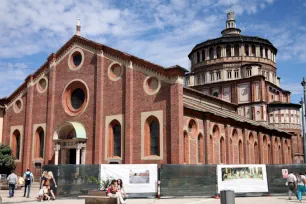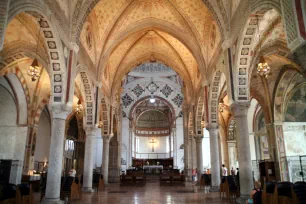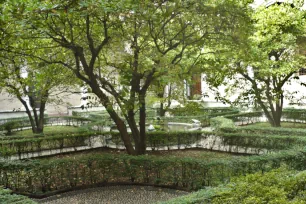The Santa Maria delle Grazie is one of Milan’s most beautiful churches thanks in part to its architectural history, which resulted in an intriguing combination of Gothic and Renaissance design.
But the church’s fame is mostly a result of Leonardo da Vinci’s ‘Last Supper’, which can be admired in the adjoining refectory.
History


In 1463 the Dominican Order commissioned Guiniforte Solari with the construction of a church for their monastery. Solari designed a beautiful structure in a late Gothic style, which was completed in 1490.
Ludovico il Moro, the duke of Milan, decided the Santa Maria delle Grazie would be a perfect sepulchre for him and his wife and in preparation asked Donato Bramante in 1492 to remodel the church. Bramante rebuilt the apse and crowned it with a magnificent sixteen-sided drum in Renaissance style. Ludovico’s wife Beatrice d’Este was buried here in 1497.
Ludovico Il Moro himself however was ousted in 1500 and his sepulchral monument was moved to the Certosa of Pavia.
In 1943 allied bombardments destroyed the main cloister. The church was damaged, but Bramante’s dome escaped unscathed. The building was restored shortly after the war, in 1947.
The Church


Both the interior and exterior show an interesting combination of Gothic and Renaissance styles. The sober brick facade was designed by Solari while the Renaissance-style entrance is attributed to Bramante.
The lunette in the portico was painted by Leonardo da Vinci and shows Mary accompanied by Ludovico and his wife. The exterior is dominated by Bramante’s masterfully designed dome, decorated with medallions of saints and coats-of-arms.
The central nave and aisles are magnificent examples of late Gothic architecture. It features elegant pointed arches embellished with delicate frescoes. The Renaissance style chancel is less decorated and seems almost sparse in contrast.
Along the aisles are a number of chapels, many of which are beautifully decorated with frescoes. Also of note are the wooden choir stalls in the apse. To the left is the entrance to the Chiostrino delle Rane, a small cloister named after the bronze frog sculptures around the edge of the cloister’s fountain. From here, you have a nice view of the church’s dome.
The Last Supper
Adjoining the church is a modest building, known as the Cenacolo Vinciano. It was built by Solari as the refectory for the Dominicans, and is now famous for Leonardo da Vinci’s painting of The Last Supper. The Italian master created the wall painting between 1495 and 1498 on request of Ludovico il Moro. The artist depicts the moment after Jesus tells his disciples that one of them will betray him. The work shows their surprise with realistic facial expressions, lively poses and subtle light.

Da Vinci used an experimental technique, known as Tempera Forte, to paint the Last Supper. This allowed him to paint with more nuances than would be possible with a conventional fresco, but already in 1518 it became clear that this technique led to a fast deterioration of the painting. In 1568 art historian Giorgio Vascari considered it a lost cause. In 1726 Michelangelo Bellotti completely repainted the work and numerous restorations followed, the last of which started in the 1970s and was concluded in 1999.
Opposite Leonardo’s masterpiece is a fresco painted by Donato Montorfano. Both paintings almost miraculously survived the bombing of 1943 which turned the rest of the refectory into ruins, probably thanks to sandbags that were placed against the walls.

